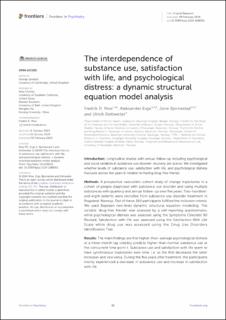| dc.contributor.author | Moe, Fredrik Dreyer | |
| dc.contributor.author | Erga, Aleksander Hagen | |
| dc.contributor.author | Bjørnestad, Jone Ravndal | |
| dc.contributor.author | Dettweiler, Ulrich | |
| dc.date.accessioned | 2024-02-22T10:10:02Z | |
| dc.date.available | 2024-02-22T10:10:02Z | |
| dc.date.created | 2024-02-09T15:26:57Z | |
| dc.date.issued | 2024 | |
| dc.identifier.citation | Moe, F. D., Erga, A., Bjornestad, J., & Dettweiler, U. (2024). The interdependence of substance use, satisfaction with life, and psychological distress: a dynamic structural equation model analysis. Frontiers in Psychiatry, 15, 1288551. | en_US |
| dc.identifier.issn | 1664-0640 | |
| dc.identifier.uri | https://hdl.handle.net/11250/3119251 | |
| dc.description.abstract | Introduction: Longitudinal studies with annual follow-up including psychological and social variables in substance use disorder recovery are scarce. We investigated whether levels of substance use, satisfaction with life, and psychological distress fluctuate across five years in relation to having drug-free friends.
Methods: A prospective naturalistic cohort study of change trajectories in a cohort of people diagnosed with substance use disorder and using multiple substances with quarterly and annual follow-up over five years. Two-hundred-and-eight patients were recruited from substance use disorder treatment in Rogaland, Norway. Out of these, 164 participants fulfilled the inclusion criteria. We used Bayesian two-level dynamic structural equation modelling. The variable ‘drug-free friends’ was assessed by a self-reporting questionnaire, while psychological distress was assessed using the Symptoms Checklist 90 Revised. Satisfaction with life was assessed using the Satisfaction With Life Scale while drug use was assessed using the Drug Use Disorders Identification Test.
Results: The main findings are that higher-than-average psychological distress at a three-month lag credibly predicts higher-than-normal substance use at the concurrent time point t. Substance use and satisfaction with life seem to have synchronous trajectories over time, i.e. as the first decreases the latter increases and vice versa. During the five years after treatment, the participants mainly experienced a decrease in substance use and increase in satisfaction with life.
Conclusion: Since the participants experienced positive and negative fluctuations for several years after treatment, it seems crucial to establish a dialogue with treatment professionals in order to create functional solutions for maintaining motivation and aiding recovery. | en_US |
| dc.language.iso | eng | en_US |
| dc.publisher | Frontiers Media S.A. | en_US |
| dc.rights | Navngivelse 4.0 Internasjonal | * |
| dc.rights.uri | http://creativecommons.org/licenses/by/4.0/deed.no | * |
| dc.title | The interdependence of substance use, satisfaction with life, and psychological distress: a dynamic structural equation model analysis | en_US |
| dc.type | Peer reviewed | en_US |
| dc.type | Journal article | en_US |
| dc.description.version | publishedVersion | en_US |
| dc.rights.holder | The authors | en_US |
| dc.subject.nsi | VDP::Samfunnsvitenskap: 200::Psykologi: 260 | en_US |
| dc.subject.nsi | VDP::Medisinske Fag: 700 | en_US |
| dc.source.journal | Frontiers in Psychiatry | en_US |
| dc.identifier.doi | 10.3389/fpsyt.2024.1288551 | |
| dc.identifier.cristin | 2244738 | |
| cristin.ispublished | true | |
| cristin.fulltext | original | |
| cristin.qualitycode | 1 | |

